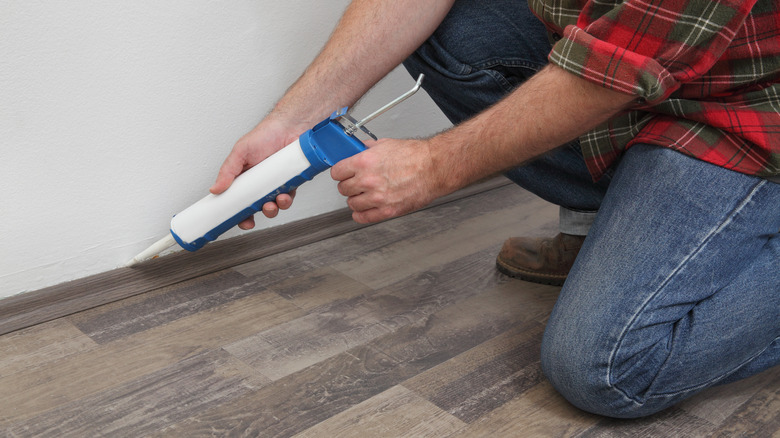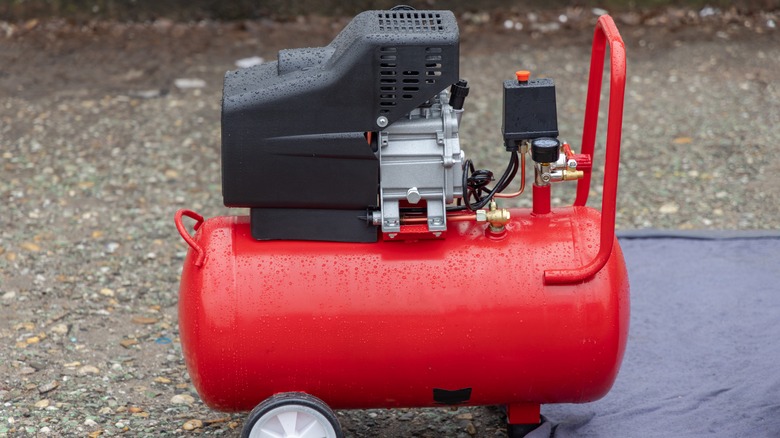How To Easily Use A Caulking Gun
Many home improvement and maintenance projects involve caulk. From weatherproofing to painting to sealing around sinks, the application is especially easy with the right caulking gun. Some simple projects can be completed with a hand-squeezable tube of caulk, but the right tool can make the job go much quicker.
Basic caulking guns are manually-operated, vary in quality and ease of use, and are readily available at any hardware store for between $3 and $10. Before you begin, make sure you choose the right caulk for your project – the right color, for interior or exterior, and whether it should be paintable.
To begin, remove the tip of the tube at a 45-degree angle – closer to the end for a smaller stream or bead of caulk and closer to the tube for a thicker bead. Then load the tube into the gun and make sure it's secure. The Home Depot says to adjust the plunger so it's fully extended by pressing the release on the back of the caulk gun and then to begin at one end of your project by placing the open tip on the joint, steadily squeezing the trigger, and moving in a smooth, continuous motion until you reach the other end.
Once the bead has been placed along the joint, Today's Homeowner advises dragging a caulk smoothing tool or a moistened fingertip along the surface to create a professional finish, but be careful to not remove too much caulk. If caulk has dripped on any unintended surface, wipe it up with a damp cloth before it sets.
Using basic caulking guns
Although economical, this type of tool can be a little messy in application and cleanup. Caulking guns have a plunger that dispenses caulk when the trigger is pulled and, unfortunately, keeps pressing on the tube despite releasing the trigger. So, some oozing always occurs, hence the mess. Placing something discardable under the tool to catch the leaking caulk when not in use is strongly advised. It's also important to note that this type of gun is tiring on the hand after a bit of use, notes Handyman's World.
Basic caulking guns feature either a smooth rod (which makes for easier application) or a ratcheted one (cheaper and more common). A smooth rod gun allows for more caulk to be dispensed using less force in a controlled manner, therefore alleviating some muscle fatigue. Also preferable is a gun with a hole on the end that is actually a built-in cutter to smoothly snip off the tip of the unopened tube of caulk. And lastly, some caulking guns have a wire poker attached to the end for clearing clogs in the tube of caulk, which is safer than using a utility to open the tube.
To use these caulking guns, you'll follow the instructions above and use the strength of your muscles to force the caulk out of the tube.
Using professional and other grade caulking guns
Higher-quality caulking guns begin at an affordable price (around $20). They operate the same as basic ones, but tend to be dripless. Professional-grade caulking guns are available as pneumatic (air-powered), electric, or battery-operated and are built to last. The many features of these quality guns make the higher cost worth it.
Electric- and battery-powered guns make caulking jobs go quicker with the simple press of a trigger, according to Handyman's World. The downside to this type of tool, however, is the need to charge the battery or having a cord to contend with while working. Both provide decent power while using and are quieter than an air-powered gun.
Prices begin at around $35 and can climb over $100. Pneumatic caulking guns require an air compressor for use and are ideal for larger DIY projects. According to ErgoPlus, air-powered guns are ergonomic and reduce elbow and wrist discomfort that's so common when using other caulking guns. Expect to pay between $45 to as much as $330 for one of these.
To use any of these higher-quality tools, you'll load the caulking gun and prepare the tube as described above, but you no longer need to use your muscles to manually force the caulk out of the tube. For most homeowner tasks, a manual caulking gun will do the job, but getting a higher-grade tool can be well worth the comfort it provides.


